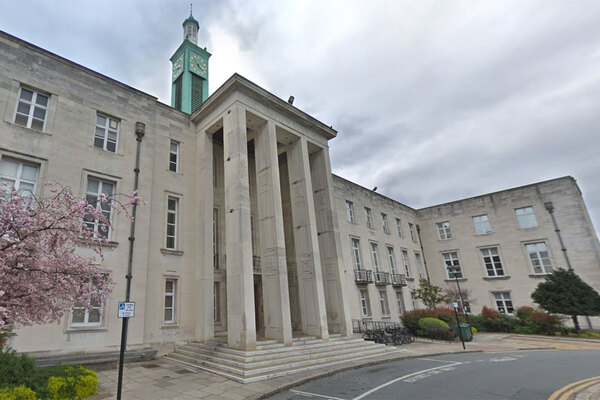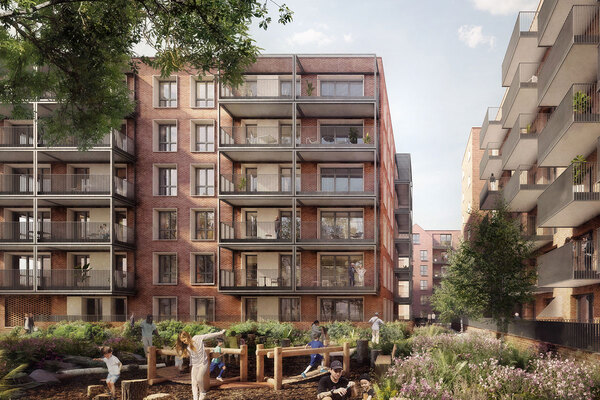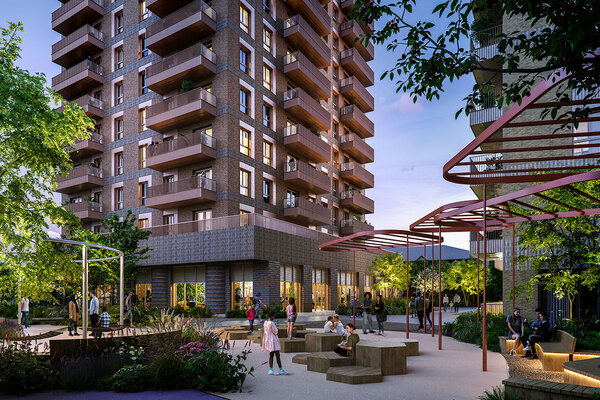The development that time forgot
It’s not uncommon for housing schemes to run into delays but plans for one development near Norwich seem positively prehistoric. Martin Hilditch investigates why it’s taken almost 60 years to build homes at Three Score and whether a new age is about to dawn for the site
On the outskirts of Norwich lies a piece of land that time forgot.
If everything had gone to plan the Three Score site, part of the village of Bowthorpe, would have been covered in housing long ago. A generation of children would have grown up here and by now they would be raising their own families.
None of that, however, came to pass. Today, the 79-acre plot looks much as it has done for time immemorial. Instead of homes, the sprawling, sloping field is occupied by a few horses and, on the day Inside Housing visits, a woman walking her dog in the bitterly cold breeze. If anything, the current view brings to mind the great works of John Constable rather than Barratt or Taylor Wimpey.
The landscape hasn’t remained unchanged for want of trying. In fact, the saga of Bowthorpe, specifically the Three Score site, has been running for so long that there are few people alive today who will remember in detail how it started.
Long-running battle
If that sounds like an exaggeration then take a look at the leader of local paper the Eastern Daily Press on 12 January 1973. Back then, it introduced plans to build new homes on the site with the words: ‘Of all the projects Norwich has initiated to house its people, none has been more protracted or become more confused than the Bowthorpe plan.
‘After nearly 20 years without a brick being laid most people have forgotten how it all began.’
If not quite Jurassic, the plans are certainly old enough by now to qualify for a free bus pass. One wonders what the Eastern Daily Press leader writer would make of the progress since those words were written. Certainly their description of a ‘still green and pleasant land’ is as true today in Three Score as it was in 1973.
After 60 years of hurt there is a new mood of optimism, however. Decades on, another local newspaper, the Norwich Evening News, hit the press in December 2012 with the headline: ‘Fresh plans for 1,000 new homes in Bowthorpe’s Three Score.’
Whisper it, but one of Britain’s most delayed developments might, finally, be about to become a reality. For what reason though is the scheme being reconsidered at a time when the housing market is far from its buoyant best? Do any stumbling blocks still lie in the way? And, most fundamentally, why on earth has it taken so long to reach this point?
To start with the last question, plans for a housing development in Bowthorpe were first put to the test in September 1954. At this stage, according to the Eastern Daily Press, a proposal from the then landowners to build new homes was turned down by planners because ‘it was felt it would create a new town on what was useful arable land’.
By the end of January 1973, after much to-ing and fro-ing, officials were keener on the idea and Norwich Council snapped up the 502-acre Bowthorpe site for a tasty £9.5 million. The intention was to build up to 10,000 homes on Three Score and two other adjoining sites in the village, known as Clover Hill and Chapel Break.
Ambitious plans
Buoyed with success, the then council leader pledged to move ahead with ‘tremendous urgency’ and the aim was to build all the homes within 15 years. Norwich’s planners had incredible ambitions for the development. In the days before the phrase ‘mixed communities’ had become ubiquitous in planning circles, the intention was to create a place that was ‘attractive’ for ‘all classes in the community’.
The entire development would be a 50/50 split between private and council housing - a reaction, according to a 2005 study, against large pre-war council estates.
Progress was initially swift with homes being built on the Clover Hill and Chapel Break sites, with the first families moving into Clover Hill in 1977. Even when the homes were under construction, however, it is apparent the process wasn’t all plain sailing. In 1980 a local councillor, Margaret Camina, was exercised enough to publish a booklet entitled Bowthorpe, the implementation of a dream: a case study in the frustrations of local government.
Ms Camina, a Norwich councillor between 1970 and 1988 was chair of the council’s finance committee in the late 1970s. Still a Norwich resident today she says that by 1980 there had been a number of niggles, including the ‘need for extra funding to cover the infrastructure costs’. But, she adds ‘there was a lot getting built’ during this time. It was, she states, the advent of the 1980s that ground the housing plans for Three Score to a halt.
‘There were two problems,’ she states. ‘The Tory government came in and weren’t so willing to support public housing [with funding] so that started to slow down.
‘Then, later on, it became a question of the road to serve Three Score and getting [plans to build it] onto the county council’s road programme. It [the Three Score development] couldn’t be built until there was another road link.’
Economic barrier
As progress slowed the 1990s arrived and with it a recession. ‘We didn’t have private developers desperate to build,’ Ms Camina adds. ‘During the 90s there was pretty much nothing [no development].’
Still, there had at least been progress on two sites. Clover Hill was largely completed by 1983 and the first phase of Chapel Break was finished by 1987, according to research partially carried out by Ms Camina and published by the Joseph Rowntree Foundation in 2005. By 2001 there were 1,597 households in Clover Hill and 779 in Chapel Break. There was even some building on Three Score in 1990 - with some 800 council homes built on the edge of the site. Nonetheless the 6,200 population by 2001 was less than half the 13,500 originally intended for Bowthorpe.

Horses grazing on the Three Score site
Just when everything seemed quiet, however, new plans for Three Score emerged at the beginning of the 21st century - version 3.0 if you will. This time the council was looking to sell the site to house builder Persimmon and outline plans for a 1,200-home development were drawn up. Three Score, just a part of that original £9.5 million land purchase by the council, was now valued at between £15 and £20 million. As the decade wore on, however, the housing market dived and the latest plans for Three Score went down with it.
At this stage it might have been tempting to give up. But then 2009 arrived and with it fresh hope. In September that year, Norwich Council entered into a collaboration and investment agreement with the Homes and Communities Agency, the government body that helps fund new development in England. The elusive Three Score development was one of the main attractions for the agency.
‘The HCA was very interested in the fact that the council still owned quite a substantial amount of land,’ confirms Gwyn Jones, city growth and development manager with the council. ‘At the same time we had a number of regeneration projects that the council had made the political commitment to but, at that time, had no funding to deliver.’
The ‘strategic partnership’ with the HCA - historic in its own right because it was the first of its kind the HCA had signed with a local authority - was to ‘accelerate the delivery of affordable homes’. A ‘major part’ of this was to focus on ‘bringing forward the Three Score site at Bowthorpe for housing’.
The HCA committed £2.5 million to help kick-start the delivery of homes at Three Score. A new masterplan was drawn up - with the number of proposed homes now falling from 1,200 to 1,000. Developer Taylor Wimpey was then selected as the preferred partner for the first phase of the development - some 180 homes and the necessary road infrastructure - although the final contract has yet to be signed.
This brings us up to speed, with the latest judgement day fast approaching for Three Score. On 14 March the outline planning application for the new scheme goes before the council’s planning committee.
‘Assuming we get outline consent and assuming that the contract is signed with Taylor Wimpey, we could be seeing some construction happening in 2014,’ states Ms Jones. When we meet at Norwich Town Hall, however, Ms Jones is quick to emphasise - repeatedly - that this is far from a done deal. At the moment the council’s focus is solely on letting the planning process run its course (in this case the council is not only the applicant, but also the planning authority).
Next steps
Unlike the council, however, Inside Housing is allowed to daydream a little. So, what would happen next if permission was granted?
‘Taylor Wimpey think their first phase will take between three to five years to build out, given the current state of the market,’ Ms Jones explains. ‘So it would take about 10 to 15 years for the whole site.’
For Norwich Council, there could be another reason to get excited about Three Score. If it proceeds the council will build its first council homes since 1992 - another historic moment. Under the current plan the council would develop 55 homes (47 for social rent and eight shared equity homes) in the first phase (30 per cent of the total). There are two main reasons the local authority wants to be involved in this way - one ethical and one financial.
‘The city council is committed to try to deliver social rent where possible,’ Ms Jones states. This would mean cheaper rents than the government’s beloved ‘affordable rent’ model, introduced following the 2010 general election, which allows social housing providers to charge up to 80 per cent of the market rate.
The main reason, however, is last year’s massive reform of the council housing subsidy system. Under the reforms, England’s 171 stock-owning councils took on a share of £29.2 billion of debt in return for being allowed to leave the centrally run subsidy system and keep hold of the rent they receive from their tenants.
A paper that went to a meeting of Norwich’s cabinet last November makes it clear that the reforms are good news for council housing in the city. In drawing up its 30-year investment plan the council realised there was a substantial gap between the amount it needed to fund the ‘Norwich offer’ - maintaining existing homes to a certain standard - and its borrowing headroom.
In fact, its financial modelling revealed ‘there is a headroom between the debt profile and the debt cap’ and that there may ‘therefore be scope for additional investment of up to £30 million over a five year period’. This enables the council to stump up the £19,000 per home needed to fund council homes with social rents.
‘Our borrowing headroom has increased significantly [since HRA reform],’ Ms Jones adds. ‘We are now able to make that investment. We are going back full circle in a way [because the 1970s plans involved council housing].’
If approved, the brief is for the first phase to be an ‘exemplar’ development. This means maximizing the use of green spaces, building homes to high environmental standards (level 4 of the code for sustainable homes) and ensuring properties face outwards onto the main streets - the original homes face away from the outskirts of the development, giving it a somewhat forbidding feel from the outside.
Final hurdles
No one will be able to breathe easily, however, until this month’s planning meeting is over and the deal with Taylor Wimpey is signed. Other potential pitfalls lie ahead, including the fact that the council does not yet know how much community infrastructure levy will be payable on the scheme. This could affect the amount of affordable homes that can be built.
Because the scheme adjoins the new build - or relatively new build - estates that make up the rest of Bowthorpe, there have been relatively few objections to the development. But, of course, there is always something.
‘Some people spotted a particular kind of [rare] wasp,’ Ms Jones adds. ‘We have had to demonstrate how we are going to mitigate against that [harming them].’
There is no question that Norwich needs new homes with the city’s current housing waiting list standing at 4,869. This contrasts with the 280 homes built in 2011/12 in Norwich.
Bowthorpe ward councillor Sally Button certainly needs no convincing. She was, after all, one of the first people to move into the new homes at Bowthorpe’s Clover Hill in 1977. Few local residents have complained about the scheme, she states, but if they do she tells them that ‘you knew then it [the land] was going to get built on from the moment you came here’. Ms Button emphasizes that people’s concerns are taken on board, however.
We stand surveying the green space that currently makes up Three Score. ‘At the end of the day you can’t stop [building] housing,’ she states. ‘People need to be housed.’
She turns and looks at the homes that form Clover Hill and adjoin the Three Score site. ‘I remember when that was all just fields,’ she states.
Perhaps one day Three Score will provoke similar memories. Today, as the Eastern Daily Press leader concluded in 1973, ‘the end of the matter still seems far away’.
Timeline
- 1954 - plans for a housing development at Bowthorpe turned down because the site is deemed to be ‘useful arable land’
- January 1973 - Norwich Council buys the 502-acre site for £9.5 million with the aim of building 10,000 homes over three sites: Three Score, Clover Hill and Chapel Break
- 1977 - first families move into Clover Hill
- 1980s - a new Conservative government and the need for extra funds to cover infrastructure costs slow development down
- 1983 - development of the Clover Hill site is completed
- 1987 - first phase of development at Chapel Break is completed
- 1990 - 800 council homes are built on the edge of Three Score but the 1990s recession slowly grinds development to a halt
- 2000s - Norwich Council looks to sell Three Score - by now worth between £15 to £20 million - to Persimmon. Plans for 1,200 homes are drawn up but the housing market crashes and the plans are scrapped
- 2009 - Norwich Council strikes a historic deal with the Homes and Communities Agency under which the HCA commits £2.5 million to help build 1,000 homes at Three Score. Taylor Wimpey is selected as preferred partner for phase one of the development
- 14 March 2013 - outline planning permission for the new scheme due before Norwich Council’s planning committee
- 2014 - development could begin pending planning approval








